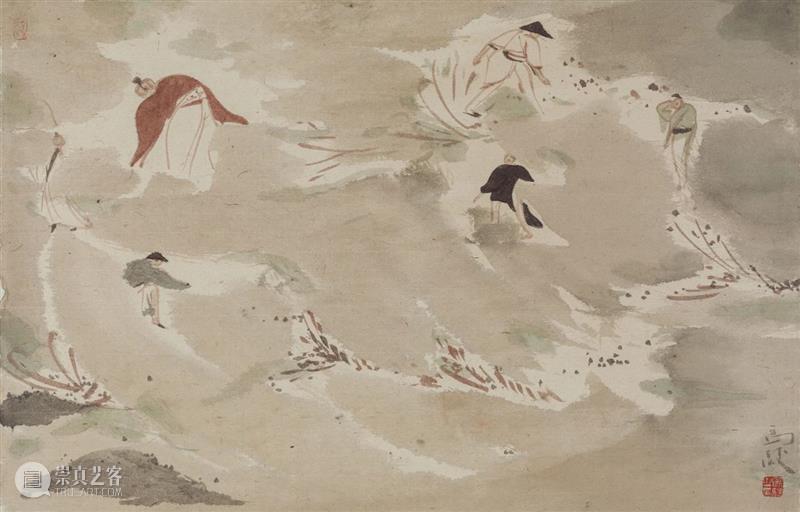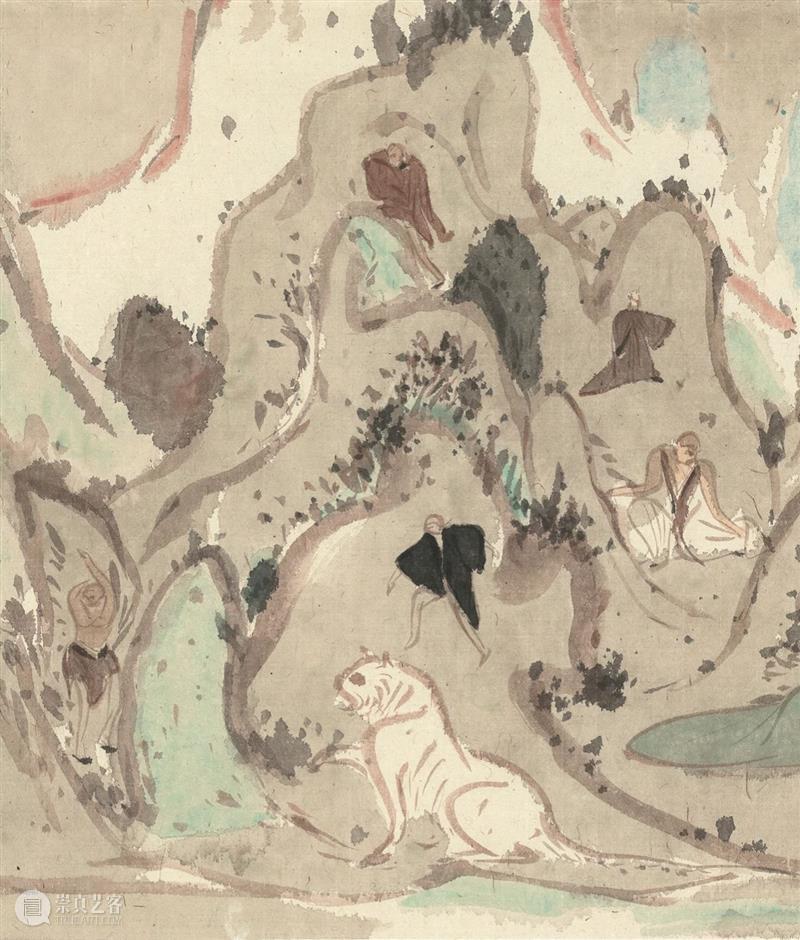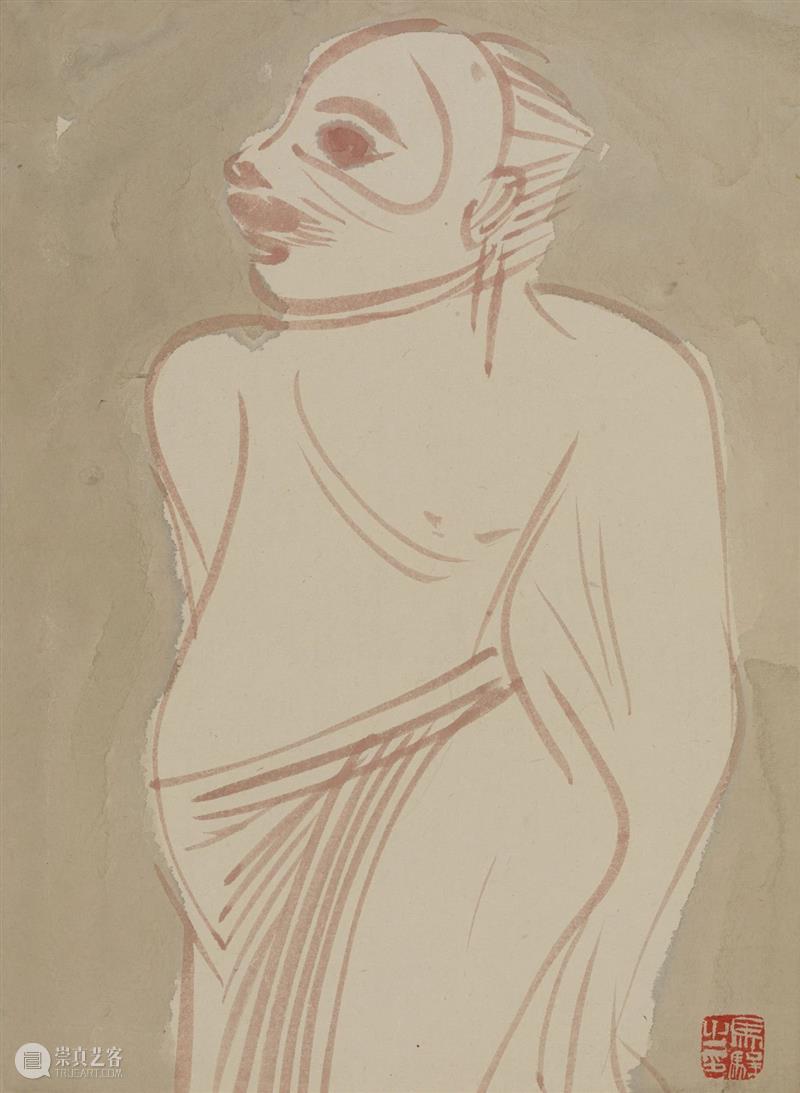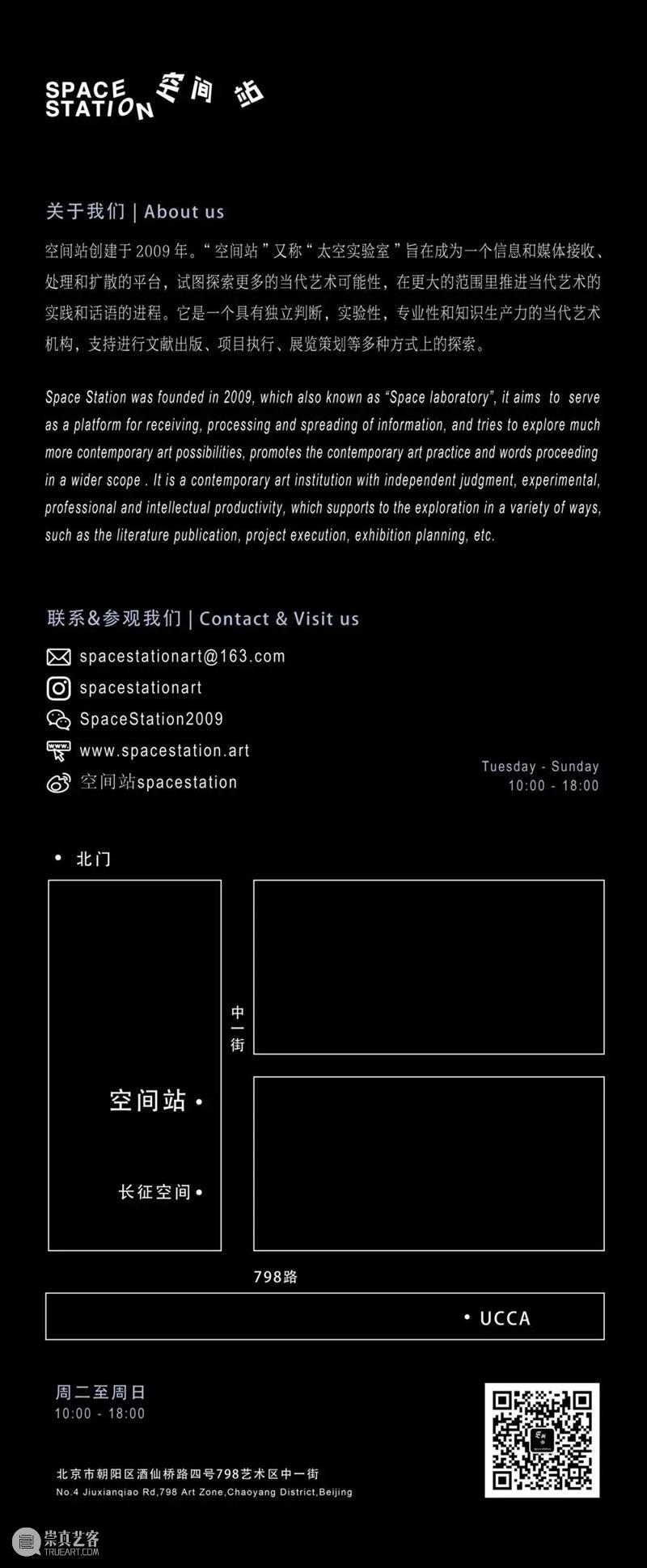

博 山 志
A Fantasy of Mount Bo
马 骏 个 展
Ma Jun Solo Exhibition
艺术家 | Artist:马骏 | Ma Jun
策展人 | Curator : 付晓东 | Fu Xiaodong
开幕 | Opening : 2023.3.18(星期六) 4:00 PM
日期 | Exhibition Time:2023.3.18 - 6.11
地点 | Venue : 北京市朝阳区酒仙桥路4号798艺术区中一街 空间站 Space Station, NO.4 Jiuxianqiao Rd, 798 Art District, Beijing
博山志 — 关于马骏个展
文:付晓东

博山/47.5x38cm/纸本设色/2023
Boshan/47.5x38cm/Ink and color on paper/2023

马骏所建立的特殊风格是在融会贯通了漫长的历史线索之后,不断尝试和迭代,基于对偶然性的触发,内心的遵从,感觉上的准确,在基本审美因素上反复提纯和凝练,形成了一个清晰的,稳定的,独特的,和历史上的文化脉络互相映照的个人结构。编织在一起的点、线、色、面之间的关系和质量,一步一步愈发纯化的语言,构造了一个内在的精神世界的整体。以一种现代主义的审美关照,从跨文明的古代艺术中,找到一种精神上的亲缘关系,吸收民间艺术的形式和结构和创造性的觉悟,打上了一种对形式自由的开拓和实验性姿态的印迹。
汉代的自然观念是“天道无为,听恣其性,故放鱼于川,纵兽于山,从其性命之欲也。不驱鱼令上陵,不逐兽令入渊者,何哉?拂诡其性,失其所宜也。”(《论衡自然篇》)“”吾所谓有天下者,自得而己。自得则天下亦得我矣。吾与天下相得,所谓自得者,全其身者也。全其身,则与道为一矣。”(《淮南子·原道训》)汉代认为自然万物皆是至上神的观念物化的显现,博山这个意向既是从“元气”这个万物之本出发,所有物象从自然混沌之中生发显现,又终消融于混沌。在最原始之物上略加刻画,于是万物互相转化,水转山,山转为灵兽与神人,再归于气,万物一圈,自然原始的万物又皆自体圆满有灵。马骏的整体观念以是在语言、形式和精神世界的探索追求中,抵达于此。在自然的墨气之中自然变化,以阴阳相生的方法,得其气,取其势,从混沌之中顺势跳脱出鲜活的形象,吞吐宇宙,生于自然、长于自然,不违天性,自然而已。博山自汉代以来,即是对于人类理想世界的描述和模仿,是一种微观的宇宙的模型。马骏的作品在不知不觉中,纷纷指向了博山上的一切,云烟之气生成芳草羽人,神兽嘉木,画中之人物我两忘,解衣磅礴,人山兽在空间中主观错落,天人在笔墨中冲淡一气,万物皆是一个整体。
 博山/48×145cm/纸本设色/2021
博山/48×145cm/纸本设色/2021
Boshan/48x145cm/Ink and color on paper/2021
 博山(局部)/48×145cm/纸本设色/2021
博山(局部)/48×145cm/纸本设色/2021A Fantasy of Mount Bo: Ma Jun’s Solo Exhibition
By Fu Xiaodong
Ma Jun grew up with a passion for traditional Chinese figure painting, from immortals and strongmen to the scenes of ordinary life. With early talent and intelligence, he is able to follow with his eyes and hands, and he claims it is due to his natural disposition. He received a rigorous education in figure painting from the Tang and Song dynasties when he entered the Tianjin Academy of Fine Arts, and learned the use of brushwork, the expressions of colors, and the techniques of line drawing. He understood that seemingly strict and meticulous paintings are all about writing and brushwork, and the more he works, the better he gets. He deeply enjoyed the pleasure of using lines and brushstrokes, and his lines were full of charm and quality. However, he was not limited to this. He often delved into the library to study various materials from ancient and modern times, both domestic and foreign, and was unable to stop himself from doing so, thus acquiring a personal trajectory that was not limited by the various fashions of the day.
 忘象/33x24.5cm/纸本设色/2023
忘象/33x24.5cm/纸本设色/2023We use our paintings to provide for our collection, and use our collection to nurture our paintings. Using a lively and energetic line as a criterion for the eyes, capturing the subtle nuances and curvature of the line, extracting the spirit of the times and embodying aesthetic concepts, taking the Northern Dynasties, which were a mixture of various ethnic groups, as the basis for ancient study, and the aesthetic conception in the Sui Dynasty as the main vein, tracing back to its origins, and exploring its evolution, for over 20 years, Ma Jun’s collection has covered the simplicity of the Qin and Han dynasties, the charm of the Wei and Jin dynasties, the elegance of the Sui and Tang dynasties, and the ancient styles of different regions of Europe and Asia, including sculptures, ceramics, objects, textiles, and accessories. Tracing its branches up and down and back to its origins, using physical objects from different eras as samples, he experiences the spiritual core of aesthetic perception across different time and space, and then delves into the linear conceptions of different schools of modelling. The depth and breadth of the accumulation is astonishing. Ma Jun’s collection is not only about objects, but also about its essence. Living with it, he can understand its intention and imbue its spirit in his work. In addition to playing with the classics, there are also places where folk art can be transformed. Its simplicity, rusticity, and liveliness embody the intuitive conceptions of primitive art as a whole world. Its aesthetic object is maximally expanded on its main vein, that is, it conveys the true meaning of tradition and breaks through the barriers of stereotypes.
 山林意/38x145cm /纸本设色 /2023
山林意/38x145cm /纸本设色 /2023Mountain and Forest Scenery/38×145cm
Ink and color on paper/2023
The point of simplicity lies in refinement. All of Ma Jun’s works spill out in one breath, surging like a fountain, encompassing all phenomena: the large and the small, the refined and the coarse, the near and the far, each with its own measure of appropriateness, without a unclear stroke impeding the fresh and lucid spirit, without a stroke of doubt, nor can a single stroke be removed from the system. The overlap of lines and ink is used to seize and cut between the various elements, and also to bloom and expand within the whole mixed unity. The abstract, functional, and concrete aspects of the lines are perfectly integrated. They are deleted again and again, reduced again and again, until the false is removed and the true is retained, until the impurities are removed and the purity is obtained. Like a pot of broth with various ingredients, though mild, it does not diminish its aromaticity; the simple strokes do not diminish the meaning, but rather achieve the unity of the mind and hands. The difficulty of portraying figures lies in the fluency of the strokes, and that implies a deep and subtle meaning that cannot be shifted in the slightest. It can be said that the strokes are soaring on the wind, yet also lofty and stable. Their weightiness, abruptness, and nimbleness penetrate to the minutest details, exerting the power of a dragonfly landing on the water, and this is a rare achievement of ancient and modern times, known only to those who have made great efforts.
Ma Jun takes a straightforward, simple style, clear and light, like phoenixes flying together among the mountains, suddenly meeting a wild deer in the woods, with a rising spirit. Instead of chasing after the intense visual stimulation of the spectacle of the consumer era and the dense and massive stacking of information, he absorbs the literati tradition of the simple in its simplicity, the majestic in its introspection, and the power of reason and feeling behind it, naturally rather than pretentiously. Ma Jun distils the true purity of vitality and the dripping expression of it in the folk traditions of the ancient world, using the harmony of pattern and raw substance to control the recalcitrant wildness. The brushwork is smooth and spontaneous, the style is pretty and easy, the ink is splashed and wielded, and there is a core of the excellence both in form and quality that mixed in a stylist way.
 纨素/39x49.5cm/纸本设色/2023
纨素/39x49.5cm/纸本设色/2023
Fine Gauze/39x49.5cm /Ink and color on paper/2023
Ma Jun’s unique style has been developed through a long process of assimilating historical clues and continually experimenting and iterating. Based on accidental triggers, inner compliance, and accurate perception, he has repeatedly refined and condensed the basic aesthetic elements to create a clear, stable, and unique personal structure that reflects the historical cultural context. The relationships and qualities between the points, lines, colors, and surfaces that are woven together, as well as the increasingly purified language, construct a complete inner spiritual world. With a modernist aesthetic perspective, Ma Jun finds a spiritual affinity with ancient art across civilizations, absorbing the forms and structures of folk art and creatively experimenting with form and style.
VI. Mount Bo
The conception of nature in the Han Dynasty is “The Dao is without effort, allowing things to follow their own nature. Thus, we release fish into the river and set beasts free on the mountains, following their desires and nature. Why not force fish to swim uphill or drive beasts into deep waters? This would violate their nature and disrupt their dispositions.” (Of Nature,Discourses in the Balance) “I speak of having the world because I possess myself. When I possess myself, the world also possesses me. I am in harmony with the world, and when I possess myself, I am in accord with the Dao. To possess oneself is to preserve one’s body, and by doing so, one becomes one with the Dao.” (Searching Out the Dao, The Huainanzi) During the Han Dynasty, people believed that all things were manifestations of the supreme god. The image of Mount Bo was both derived from the “primordial energy” of all things and manifested from the chaos of nature. Everything was interconnected, with water turning into mountains, mountains becoming spirit beasts and immortals, and ultimately returning to the primordial energy, completing the cycle of all things. By lightly sketching out the most primitive elements of things, everything could be transformed, allowing nature to take its course. Ma Jun’s outlook is reached through his exploration and pursuit of language, form, and the spiritual world. In the natural ink, his strokes naturally change and follow the method of the unity of Yin and Yang to obtain their Qi and take their momentum. From the chaos, the strokes jump out of vivid images and swallow the universe, born in nature, grown in nature, not violating nature, simply natural. Since the Han Dynasty, Mount Bo has been a description and imitation of the ideal world of mankind, a microcosmic model of the universe. Ma Jun’s works unconsciously refer to everything on Mount Bo, where clouds and smoke generate fragrant grass and feathered people, mythical creatures and auspicious trees; the figures in the paintings forget the distinction between oneself and the outside world; humans and animals are subjectively intertwined in one space; the divine and immortals blend seamlessly in ink, and all things integrate into a whole.
 山林意/76×145cm/纸本设色/2020
山林意/76×145cm/纸本设色/2020艺术家简介
Ma Jun




已展示全部
更多功能等你开启...





 分享
分享